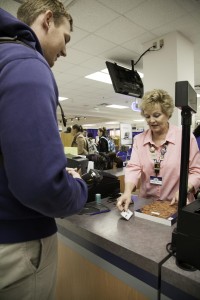
The BYU Store and RedShelf have partnered together to bring a new interactive textbook experience to BYU students.
RedShelf was founded in 2010 as a Chicago-based digital book rental startup and now is partnered with Pearson, McGraw-Hill, Cengage, MacMillian and John Wiley & Sons. RedShelf is one of the few education tech startups to have a direct partnership with all five publishers. RedShelf has partnered with more than 150 university bookstores, with the BYU Store being one of them.
RedShelf describes itself as an ambitious team based in Chicago, focused on delivering eTextbooks more simply and affordably. “Most of us at RedShelf were students not long ago and have experience with both paper and digital textbooks,” the company’s website says. “This has allowed us to look critically at how software can be used to create eTextbooks that help students study, learn, and ultimately achieve their academic goals.”
RedShelf works through a “Bring Your Own Device (BYOD)” technology, where students would only need access through a web browser to reach their course materials.
Some students at BYU have already had experiences with digital textbooks, and the reviews are mixed. Morgen Kohtz, a junior from Kansas City, Missouri, studying English teaching, has used both digital and print textbooks but prefers print.
“There are a lot of distractions when you are on your computer with digital textbooks,” Kohtz said.
Matthew Critchley, a senior from Sedro-Wooley, Washington, studying accounting, likes using digital because it is cheaper. “I saved a couple hundred dollars by buying the digital version. It was great,” he said.
Tom Hirtzel, BYU’s academic resources manager, said it’s more than just about preferences; it’s about the learning outcome. Studies about print textbooks vs. digital textbooks also have mixed reviews. Research by an Indiana State University doctoral student found that students did equally well on a test whether reading from a printed book or a digital one. The School of Information’s Student Research Journal performed a study that showed students can recall more information from their print readings than from their digital readings.
“The assumption digital is better is not conclusive. Studies have not shown digital is always better,” Hirtzel said. It is still unclear if digital can provide the same learning outcomes as print textbooks, yet the push for digital textbooks continues. “It is higher education publishers that are pushing for digital,” Hirtzel said.
Publishers are the most motivated to sell digital because of the used-textbook market. “The used-book market is an enemy to publishers,” Hirtzel said. He said that in an average class, only 1/3 of the students will buy the new book, while the rest will most likely buy used. This means that publishers only make money from 1/3 of the class.
Hirtzel said publishers are marketing rental interactive digital textbooks that expire once the course has ended. A new semester means a brand-new access code, cutting out any possibility for students to buy a used version. “They want it to expire,” Hirtzel said.
RedShelf knows there are students like Jenna Jacobson, a sophomore from Portland, Oregon, studying elementary education, who like the benefit of print textbooks but also like the eTextbooks prices.
“The rental eBooks seem like a better deal,” Jacobson said.
RedShelf has incorporated some aspects of print textbooks into its interactive digital textbooks. “With familiar tools such as bookmarking, highlighting and note-taking, our eTextbooks software allows students to study and learn like they would with paper,” RedShelf said on its website. Professors can even go on to RedShelf and highlight sections and write notes in the margins for their students.
“It is more of a social media type of experience,” Hirtzel said.
The textbook market is evolving as publishers, professors and students experiment with the new digital options. Students know themselves and their learning styles best when it comes to deciding which path to take.
“Education is a very subjective thing … how someone learns and what is the best way to learn is open to debate,” Hirtzel said. “It is not our job to tell students what is best for them.”




